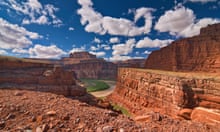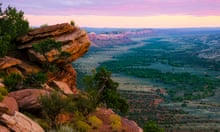Donald Trump is shrinking two national monuments in Utah, accepting the recommendation of interior secretary Ryan Zinke to reverse protections established by two Democratic presidents, a Republican senator said Friday.
Utah senator Orrin Hatch said he was “incredibly grateful” that Trump called him on Friday to say he is approving Zinke’s proposal on Bears Ears and Grand Staircase-Escalante national monuments.
He and Trump “believe in the importance of protecting these sacred antiquities”, but said there is “a better way to do it” by working with local officials and tribes, Hatch said.
Zinke recommended in September that the two Utah monuments be shrunk, along with Nevada’s Gold Butte and Oregon’s Cascade-Siskiyou. The interior secretary had conducted a review of dozens of areas protected by presidential decree since 1996.
Environmentalists reacted furiously to Hatch’s announcement and immediately vowed to use the courts to halt the reduction of the monuments.
“Trump has declared all-out war on public lands. Stripping protections for these national treasures is just the beginning of his assault,” said Randi Spivak, public lands program director for the Center for Biological Diversity.
“Trump sees our national monuments as nothing but profit centers for corporate polluters. We won’t allow him to destroy these cherished places. We’ll sue and we’ll prevail.”
Green groups have been joined by some tribal leaders and business interests in calling for the Bears Ears and Grand Staircase-Escalante monuments to be preserved, arguing that the cultural and tourism value of the land far outweighs any benefit from drilling or grazing.
“President Trump and Ryan Zinke’s attack on the Grand Staircase Escalante national monument is an attack on southern Utah’s entrepreneurs and the thousands of jobs that depend on the monument,” said Suzanne Catlett, president of the Escalante and Boulder Utah chamber of commerce.
“The utter disregard for our thriving community and the views of local business owners like me, shows that president Trump could care less about jobs in rural America.”
The two Utah monuments encompass more than 3.6m acres – an area larger than Connecticut – and were created by Democratic administrations under a century-old law that allows presidents to protect sites considered historic, or geographically or culturally important.
Bears Ears, designated for federal protection by Barack Obama, totals 1.3m acres in south-eastern Utah on land that is sacred to Native Americans and home to tens of thousands of archaeological sites, including ancient cliff dwellings. Grand Staircase-Escalante, in southern Utah, includes nearly 1.9m acres in a sweeping vista larger than the state of Delaware.
Republicans have howled over the monument designation since its creation in 1996 by Bill Clinton. Conservation groups and tribes have vowed to file lawsuits if Trump attempts to rescind or reduce the monument designations.
Trump asked for the review this spring following complaints by Hatch and other Republicans that the 1906 Antiquities Act had been misused to create oversized monuments that hinder energy development, logging and other uses. The review included sweeping sites mostly in the west that are home to ancient cliff dwellings, towering sequoia trees, deep canyons or ocean habitats roamed by seals, whales and sea turtles.
National monument designations add protections for lands revered for their natural beauty and historical significance with the goal of preserving them for future generations. The restrictions aren’t as stringent as national parks, but some policies include limits on mining, timber cutting and recreational activities such as riding off-road vehicles.
No president has tried to eliminate a monument, but they have trimmed and redrawn boundaries 18 times, according to the National Park Service.








Comments (…)
Sign in or create your Guardian account to join the discussion